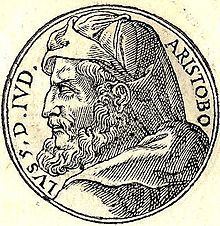Reign c. 104–103 BC (1 year) Role Ruler Royal line Hasmonean dynasty Name Aristobulus I Siblings Alexander Jannaeus | Father John Hyrcanus I Spouse Salome Alexandra Successor Alexander Jannaeus Died 103 AD | |
 | ||
Predecessor John Hyrcanus, Maccabean prince only Nephews Hyrcanus II, Aristobulus II Similar People Aristobulus II, Alexander Jannaeus, John Hyrcanus, Hyrcanus II, Salome Alexandra | ||
Judah Aristobulus I (Greek: Ἰούδας Ἀριστόβουλος Ioúdās Aristóboulos, the epithet meaning "best-advising"; reigned c. 104 – 103 BC) was the first ruler of the Hasmonean Dynasty to declare himself "king". He was the eldest of the five sons of John Hyrcanus, the previous leader.
Contents
- Ascension as king
- Conquest of Galilee
- Death and successor
- Galilee and Golan settlements
- Coinage
- References

Aristobulus was not only just the first king from the Hasmonean lineage, but the first of any Hebrew kings to claim both the high priesthood and the kingship title. The Sadducees and the Essenes were not concerned about Aristobulus taking the title of king, but the Pharisees were infuriated: they felt that the kingship could only be held by descendants of the Davidic line (the Hasmoneans were Levites). The Pharisees began a massive rebellion, but Aristobulus died before any attempt to depose of him could occur.
Ascension as king
According to the directions of John Hyrcanus, the country after his death was to be placed in the hands of his wife, and Aristobulus was originally to receive the high-priesthood only. Aristobulus did not approve of his father's wishes, instead, he seized the crown with the support of his brother Antigonus. To secure his kingship, he had his mother placed in prison where she starved to death; and to ensure himself of any possible endangerment from his family, he placed his three brothers into prison except for Antigonus.
Conquest of Galilee
Much of the Galilee region was annexed by Aristobulus, however, there was some resistance from the Arab Ituraean tribes from the northern parts of the region. The terrain made campaigning difficult against the Galilee inhabitants. In the end, Aristobulus would eventually conquer much of the territory from them. The Golan region was also taken during the campaign and Mount Hermon as well. The conquered inhabitants were forced to accept the Jewish faith, primarily, circumcision was forcibly performed as the main step to conversion.
Death and successor
Aristobulus's feeble health gradually lead his remaining reign under the control of a clique, at the head of which stood Queen Alexandra Salome, his wife. Through his machinations reign, he was led to suspect his favorite brother, Antigonus—whom he had entrusted with a share in the government, and whom he treated almost as a coregent—of designs against him. When he showed signs of disease, the queen conspired to murder Antigonus. She deceived the king with suggestions that Antigonus was attempting to overthrow him by force. Salome then convinced Antigonus that his king wished to see his new armor, while telling Aristobulus that his brother was coming to kill him. Antigonus was killed by Aristobulus's guards before he could get close to his brother. Days later, Aristobulus died from pain and internal bleeding from an unknown disease, which Jews perceived his death as a sign of God's disgruntlement. The queen released the younger brothers from prison, placing Alexander Jannaeus on the throne.
Galilee and Golan settlements
Archaeological findings in eastern Galilee and lower Golan reveal massive ethnic changes in the area just before, during, and immediately after Aristobulus's reign. Beginning with John Hyrcanus and ending with Alexander Jannaeus, large numbers of pro-Hasmonean Jews immigrated into those territories to support Hasmonean political, economic, and religious ideology, displacing much of the indigenous population. Although many of these towns were later seized by Roman forces who instituted pro-Hellenic policies, the previous Hasmonean influence survived and would incite conflict during and after the rule of Herod the Great.
Coinage
The first mint of Hasmonean coins didn't begin until the leadership of John Hyrcanus. Like his father, Judah Aristobulus only minted his coins with the title of the high priesthood. It wasn't until Alexander Jannaeus that both the roles of kingship and the high priesthood were minted onto coins. The majority of Judah's coins were found in the regions of Galilee and the Golan, primary, the largest amount of coins were from Gamla. Majority of them come from his actual reign, while a small amount of these coins were minted after.
